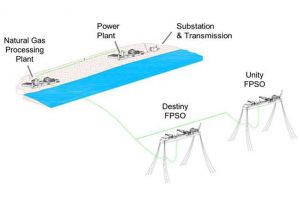-Construction aspect to create more than 600 jobs
ONCE operational, the heavily-touted gas-to-shore project will have a duration of approximately 25 years, according to ExxonMobil’s subsidiary, Esso Exploration and Production Guyana Limited (EEPGL).
In a project summary recently submitted to the Environmental Protection Agency (EPA), the oil company said that the US$900 million project will be executed in several phases – engineering, construction, commissioning, operations and decommissioning.
“The engineering phase will include design, front-end engineering and design (FEED), and detailed engineering. The construction phase will include procurement, fabrication and construction, installation, commissioning and start-up,” the document, as seen by this newspaper, outlined.

It explained that the operations aspect will be the longest phase of the project, with a duration of at least two and a half decades.
“Startup of the facilities is expected to occur in 2024,” the summary indicated. The ground-breaking project will include the construction and operation of a pipeline from the Liza Phase 1 and Liza Phase 2 Floating, Production, Storage, and Offloading (FPSO) vessels to an onshore natural gas liquid (NGL) and natural gas processing (NGP) plant.
“The pipeline will transport up to approximately 50 million standard cubic feet per day (MSCFD) of dry gas to the NGL Plant,” the document informed.
It related too that, “the NGL Plant will drop the pressure of the gas, dehydrate the gas, separate out propane, butane and pentanes+, and treat the gas to the specification to be received by a planned power plant.”
The gas-to-shore project will be established at Wales, West Bank Demerara, the document reminded.
“A comprehensive site evaluation process was conducted…20 sites were evaluated based on a number of criteria, including topography/elevation, soil conditions, biodiversity, socioeconomic factors, site access, and pipeline routing,” the EPA was told.
The oil company said that of all the sites assessed, the plot at Wales was determined to be most most suitable, based on constructability, environmental, socioeconomic, and biodiversity perspectives.
Added to that, the oil company also has plans to utilise the plot of land just adjacent to the intended project site. The area, which accounts for mainly abandoned sugarcane fields, is owned by the Guyana Sugar Corporation (GuySuCo).
“The site is generally of low value to wildlife. No critical biodiversity (plant or animal) is expected to occur at the site. There is no human habitation at the site…there are no known cultural sites or traditional uses within the site,” the company justified.
Once established, the power plant will be owned and operated by Government of Guyana until alternative ownership options are considered.
EMPLOYMENT
In its outline to the EPA, the oil company also pointed to a preliminary workforce estimate which projected that the construction phase of the initiative alone would create at least 600 jobs.
Additionally, the document informed that there will be a comparatively smaller number of personnel who will be tasked with providing shorebase and logistical support on shore.
“The onshore staff will be expected to ramp-up gradually through the mobilisation and installation stage, until reaching a maximum level during the construction and installation activities, and then diminishing during operations.
“The onshore staff is expected to increase again briefly during decommissioning. Logistical support is expected to be shared among all of EEPGL’s activities,” the document indicated.
It noted too that prior to the end of the project’s life, a decommissioning programme will be submitted for approval by the government. EEPGL said that it will then select, in consultation with the appropriate Guyanese agencies, the final decommissioning strategy based on a comparative assessment, which is designed to evaluate the potential safety, environmental, technical, and economic impacts, and associated mitigation measures in order to finalise the decommissioning programme.
The gas-to-shore project forms a major part of the People’s Progressive Party/Civic (PPP/C) government’s plan to reduce the cost of energy by at least 50 per cent through an energy mix, which includes the conversion of natural gas from ExxonMobil’s offshore operations to electricity.
This is especially important, since Guyana is said to have one of the highest cost of power generation in the world, a factor which has discouraged many businesses from investing here.
In recently reaffirming the viability of the project, former President and current Vice President, Dr. Bharrat Jagdeo, highlighted that the initiative could see Guyana saving approximately US$150 million on power generation annually.
“What this brings is long term stability to the price, so we are immune from future market fluctuations, especially the upward movement of the cost of the bunker and other fossil fuels,” Jagdeo told a recent press conference.
Once realised, the project could also mean less blackouts and a more reliable supply of power across the country.




.png)









